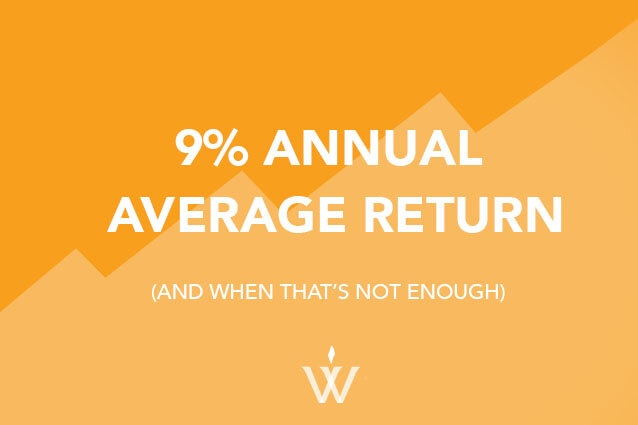IS A 9% ANNUAL AVERAGE RETURN ENOUGH FOR YOUR CLIENTS IN RETIREMENT?
It took close to 5 years for the stock markets to recover from the 2008 crash. We know that time can heal market losses, but how many of your clients may not have that sort of luxury? With today’s sustainable withdrawal rate hovering around 2%*, due to record low bond yields and higher than average stock valuations, pre-retirees are in a very tricky spot today. These factors amplify sequence of return risk because pre-retirees must seek returns to build their nest eggs larger than they would have in the past. In doing so pre-retirees expose themselves to more risk.
How do you demonstrate timing and sequence of returns risk with your clients? The consumer-facing sales tool “The Hatfields and Mccoys” tells a simple yet effective story on sequence of return risk. In the piece, we examine two hypothetical families entering retirement at age 65, but under different circumstances. Both families retire with $500,000 of their nest egg fully invested in the S&P 500® index. They both withdraw 4% annually, with a 2.5% increase each year to keep pace with inflation. The McCoys experience the annual returns from years 1978 to 2008, while the Hatfields experience the same returns, but in reverse chronological order, with a key point being that the annual return for 2008 occurs during their first year of retirement and the return for 1978 is their last.
Why did we pick those years? From 1978 to 2008 the S&P 500® experienced average annual growth of 9.21%, which is above the historic average. This period also features multiple market cycles and when shown in reverse chronological order demonstrate the risk of a bear market early in the Hatfield’s hypothetical retirement.
The McCoys receive 100% of their expected income from their portfolio over 30 years, which amounts to $878,054. Additionally, they have $2,721,569 leftover. While the Hatfield’s initial loss, results in exhausted savings by age 90. Currently, we may be facing a recession that will affect today’s pre-retirees if they are not prepared.
Over an extended time frame, intra-period losses do not have as large of an impact on portfolios. Primarily because, investors have a longer time-horizon prior to recover from those losses. The reality is that market returns are not experienced in a straight line and the hypothetical illustration of the immediate loss that the Hatfields experience, shows that sequence of return risk can be harmful to a successful income plan.
Tell this story to individuals who are in the earlier stages of retirement. Especially ones who are starting to liquidate some of their equity positions or are trying to find a home for assets that they have accumulated in their 401(k) over the years. Many clients may not understand the nuances of interest rate risk, despite being risk averse.
The good news is that there are options to help in the income phase of retirement. While yields are low in traditional fixed income offerings, there are products with positive annual growth and guaranteed monthly income that may fit well in many clients' income plans. If you have clients heavily invested in equities who are nearing retirement, work with them on principal, or partially principal protected products to help reduce their exposure to sequence of return risk. For more on the Hatfields and McCoys, download our whitepaper on Timing Risk.
To download the Hatfields and McCoys Click here
Check out the video below for more on the Hatfields and McCoys.
*WealthVest, Sustainable Withdrawal Rates for New Retirees in 2019, Bozeman, MT, 2019 This is a hypothetical example used for illustrative purposes only, assuming an initial portfolio value of $500,000. Chart assumes a 4% rate of withdrawal beginning in year 1, with a 2.5% annual increase of the net withdrawal amount to account for inflation. This is based off of Social Security Cost of Living Adjustments’ average increase from 1990 to 2018. Cost-of-Living Adjustment (COLA) Information, https://www.ssa.gov/cola/. Actual S&P 500® historical data from 12/29/1978 to 12/31/2008 has been used in this graph. The hypothetical illustration does not consider the impact of taxes, which would reduce all values. Time period selected because of the extreme volatility during the 2000s, to better illustrate the impact of significant losses early in retirement. Using the current time period would demonstrate less dramatic results. Returns are based upon the Standard & Poor’s® 500 Index (S&P 500® Index) historical data from 1978 to 2008. S&P 500® Index returns for the Hatfields are in reverse chronological order. The S&P 500® Index is an unmanaged group of large company stocks. It is not possible to invest directly in an index. Past performance does not guarantee future results. Please note that in order to provide a recommendation to a client about the liquidation of a securities product, including those within an IRA, 401(k), or other retirement plan, to purchase a fixed or variable annuity or for other similar purposes, you must hold the proper securities registration and be currently affiliated with a broker/dealer or registered investment advisor. If you are unsure whether or not the information you are providing to a client represents general guidance or a specific recommendation to liquidate a security, please contact the individual state securities department in the states in which you conduct business. For Financial Professional Use Only. Not for the use with the general public.C1006 04/15/20

